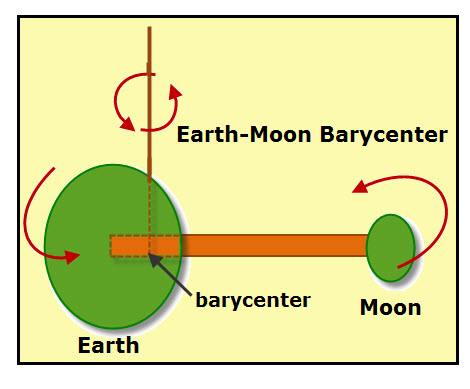Did You Know that the Moon Doesn’t Orbit the Earth?
Orbit means to move in a curved path around another something. In astronomy, celestial bodies are generally described as moving or orbiting some other celestial body. For example, the Moon is said to orbit or revolve around the Earth. The Earth doesn’t stays in position as the Moon circles it.
Instead, the Moon as well as the Earth orbit the barycenter between the two celestial bodies. WOW!!! This sounds very complex—UUM! I guess it is, but its relatively easy to model and while the concept of the two celestial bodies orbiting a spot in space is a bit difficult, even young kid will find the activity fun.

The animation represents how the Earth-Moon System orbits the system’s barycenter. The barycenter the center of mass of an object or system (group of objects). OOPS! I think I need to define center of mass—which is the average position of the mass of the system. Another way of saying this is that the barycenter (center of mass) is where the mass of the system appears to be concentrated. This point is an imaginary position and can be between the objects or as shown by the red x in the diagram, can be within the surface of one object. This is true for the Earth-Moon system.
The Red Plus Sign (+) marks the barycenter of the Earth-Moon System. Notice that the barycenter is within the surface of the Earth. Don’t be confused about this. The barycenter is not a specific place on Earth, such as in Texas or Germany. Instead, it is a place in space between two objects.
The animation doesn’t begin to show all the motions for these two celestial bodies. Both the Earth and Moon are rotating on their axis, much like spinning tops. Together the Earth-Moon system is orbiting the Sun, and ——yes there is more but my head is spinning now trying to visualize it all. WHAT FUN!!!
This animated diagram was created by Zghatt and posted on wikipedia.
http://en.wikipedia.org/wiki/File:Orbit3.gif
Discover for Yourself
 How to model the barycenter for the Earth-Moon system.
How to model the barycenter for the Earth-Moon system.
1. On the end of a 36″ dowel rod. (Any thin rod will work-length is not critical, but around 36 ” is easier to balance.) place a small ball of clay.
2. Tie the string near the end of the rod opposite the small clay ball.
3. Mold a large ball of clay around the end of the rod so that the supporting string is withing the surface of the ball as shown.
Add more clay as well as move the string along the rod until this system balances.
Note: If possible, tie the free end of the string to a support. The Rod-Clay System should be able to swing freely as well as to rotate around the string.
4. Once the system is balanced on the string, push one end so that it spins around the supporting string.
What to Expect:
The barycenter is within the larger clay ball, thus the string sticks out of the large clay ball. The difference between the mass of the Earth and its moon are examples of this difference. Remember that the barycenter is a place in space between two bodies.